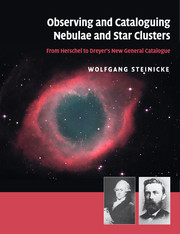Book contents
- Frontmatter
- Contents
- Preface
- 1 Introduction
- 2 William Herschel's observations and parallel activities
- 3 John Herschel's Slough observations
- 4 Discoveries made in parallel with John Herschel's Slough observations
- 5 John Herschel at the Cape of Good Hope
- 6 The time after Herschel's observations until Auwers' list of new nebulae
- 7 Compiling the General Catalogue
- 8 Dreyer's first catalogue: the supplement to Herschel's General Catalogue
- 9 Compilation of the New General Catalogue
- 10 The New General Catalogue: publication, analysis and effects
- 11 Special topics
- 12 Summary
- Appendix
- References
- Internet and image sources
- Name index
- Site index
- Object index
- Subject index
10 - The New General Catalogue: publication, analysis and effects
Published online by Cambridge University Press: 06 December 2010
- Frontmatter
- Contents
- Preface
- 1 Introduction
- 2 William Herschel's observations and parallel activities
- 3 John Herschel's Slough observations
- 4 Discoveries made in parallel with John Herschel's Slough observations
- 5 John Herschel at the Cape of Good Hope
- 6 The time after Herschel's observations until Auwers' list of new nebulae
- 7 Compiling the General Catalogue
- 8 Dreyer's first catalogue: the supplement to Herschel's General Catalogue
- 9 Compilation of the New General Catalogue
- 10 The New General Catalogue: publication, analysis and effects
- 11 Special topics
- 12 Summary
- Appendix
- References
- Internet and image sources
- Name index
- Site index
- Object index
- Subject index
Summary
After having presented all of the information which contributed to the making of the NGC, this section treats Dreyer's publication of 1888 and analyses the structure of the catalogue. It appeared in Vol. 49 of the Memoirs of the Royal Astronomical Society and is titled ‘A new catalogue of nebulae and of clusters of stars, being the catalogue of the late Sir John F. W. Herschel, Bart., revised, corrected, and enlarged’ (Dreyer 1888b). The main topics of the following Sections 10.1 and 10.2 are:
the temporal development of discoveries (1800–1887)
the number of independent NGC objects
discoverers (success rate, nationality)
telescopes (aperture, type, site, nationality)
the distribution according to modern object types
the presentation of special objects
the distribution of visual brightness
missing data
After 1888, Dreyer and other astronomers collected corrections and supplementary data regarding NGC objects. Moreover, many new non-stellar objects were found, mainly by photography. To keep track, Dreyer published two Index Catalogues, in 1895 and 1908, containing the new data (Section 10.3). NGC-numbers are mentioned in nearly all modern catalogues (e.g. of galaxies, galactic nebulae and open clusters), albeit not always correctly. This is mainly due to the fact that the original NGC is not user-friendly and thus difficult to compare with modern data. Moreover, it contains errors, which were simply reproduced.
- Type
- Chapter
- Information
- Observing and Cataloguing Nebulae and Star ClustersFrom Herschel to Dreyer's New General Catalogue, pp. 439 - 471Publisher: Cambridge University PressPrint publication year: 2010



